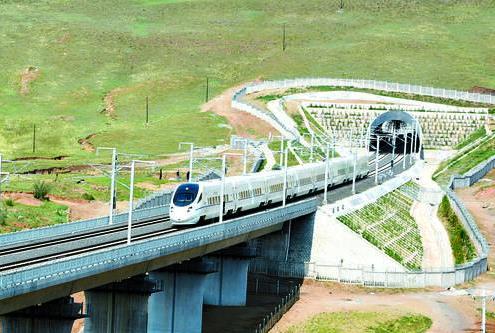A new high-speed rail line that connects Jilin province to Inner Mongolia Autonomous Region is set to open this Tuesday.
The project is part of the broader efforts to revitalize the economy of the rust belt region.
|

|
|
The high-speed rail way connecting Jilin province to Inner Mongolia Autonomous Region runs from Changchun to Ulanhot. [Photo/sina.com]
|
It is also the first trans-regional high-speed railway for Inner Mongolia.
The more than 400-kilometer railway runs from Changchun, the capital of Jilin province, to the city of Ulanhot, which is located next to Inner Mongolia’s border with Jilin.
Baicheng, a city on the Jilin side of the border, will serve as the largest stop along the route.
Renovation of the original railway through the area began in late 2014 in order to accommodate high-speed trains.
Cao Like, a railway official with the Jilin Provincial authority, says the renewal project is a big step forward in both speed and capacity.
“The new railway has a 60-million-ton load capacity for cargo, whereas the old railway could only accomodate 10 million tons. Cities along the route are now closer to each other. For example, from Changchun to Baicheng now only takes 2 hours and 40 minutes. Before today, it would have taken more than 4 hours.”
Xia Fan with the China Railway Corporation was the head of the team that renovated the railway.
He says they’ve made changes which should allow for even faster trains on the line in the future.
“We conducted an electrification-based renovation to the railway, as well as an upgrade to its communication systems. Speed of trains now will be limited to 160-kilometers per hour. But we’ve made the electrification of the line at a very high standard. So in the future, it will be feasible to raise the maximum speed to 200 kilometers per hour.”
The railway is bringing high-speed train services to the western part of Jilin for the first time.
Songyuan, a small city along the route, is home to Chagan Lake.
Residents near the lake are renowned for their thousand-year-old tradition of fishing during the winter.
Yan Liang, a local villager, has decided to expand his fish restaurant after hearing news about the new railway.
“We’re going to have a growing number of tourists coming. My previous restaurant was just a small courtyard. It can’t meet the demands of my customers, many of whom now need a place to stay overnight. So I decided to rent a big house for my business earlier this year.”
The renovated railway connects to the current high-speed line running from Harbin, the capital of Heilongjiang, and Dalian, which is located at the bottom of the Liaodong Peninsula in Liaoning.
China’s northeast, a combination of the provinces of Liaoning, Jilin and Heilongjiang, is more than twice the size of Japan.
Authorities are planning to establish a high-speed railway network in the northeast by 2025 which will cut travel times throughout most cities in the region to no more than 2-hours.
Interconnection is viewed as a critical step in pulling the so-called ‘rust belt’ out of its current economic woes.
The three northeastern provinces have undergone the worst economic slowdown across the nation over the last few years, dragged by industrial overcapacity and inefficient state-owned businesses in the region.
Both the central and local authorities have been implementing plans to revitalize the local infrastructure, as well as tap the region’s natural beauty and ruggedness as a draw for tourists.
read more


